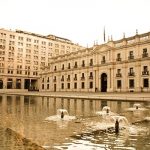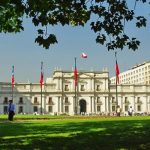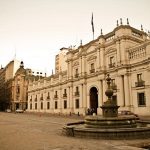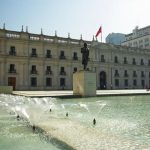Overview
The headquarters of the Executive Power and one of the most representative symbols of the country’s political history.
Designed by architect Joaquín Toesca, this palace is the main neo-classical work in Chile. It was officially opened in 1805 as the headquarters of the Royal Mint of Santiago, designed to mint coins. In 1846, President Manuel Bulnes had the seat of Government moved to this building, and was the first head of state to live there. The last was Carlos Ibáñez del Campo, in 1958.
The building also became the scenario for one of the most decisive events in the history of Chile –the bombing that it was subject to on September 11, 1973. Following this event, a group of architects refurbished it, keeping the original lines designed by Toesca.
Since then it has undergone some changes, such as having been painted white towards the close of the last century, or the renovation of Plaza de la Ciudadanía (Citizens’ Square), under which the La Moneda Palace Cultural Center was built.
It was declared a National Monument in 1951.
History
It is considered to be the main neo-classical work in Chile, designed by architect Joaquín Toesca.
Its construction commenced in 1784, using materials brought from sectors near the city of Santiago. Stones from the San Cristóbal Hill quarry and bricks from Polpaico were used. It was inaugurated, albeit unfinished, in 1805, as the headquarters of the Royal Mint of Santiago.
In 1846, the seat of Government was moved to this site. Manuel Bulnes was the first head of state to live in this building, and Carlos Ibáñez del Campo was the last, in 1958.
It also became the scene for one of the most decisive events in the history of Chile, namely the bombing of September 11, 1973, which destroyed the facilities.
During the reconstruction process, the seat of Government was moved to the Diego Portales building, currently the Gabriela Mistral Cultural Center, while the traditional door on 80 Morandé street was closed.
The repair work to strengthen the foundations used modern techniques. Plaza de la Constitution (Constitution Square) and, under it, parking lots and offices for the palace staff, were built.
The building was reopened in March 1981.
In 2003, thirty years after the military coup, the administration of President Ricardo Lagos decided to rebuild the entrance of 80 Morandé street, where once the leaders could enter without receiving the honors of the guard. It was through this door that the mortal remains of Salvador Allende were removed in 1973.
Architecture
A neoclassical building, inside which are the Los Cañones and Los Naranjos courtyards; the latter houses the old water fountain that used to supply the city of Santiago in Colonial times.
Its main facade is located on Calle Moneda, facing the Plaza de la Constitución. Inside are the following spaces:
Independencia Room. This room features the most emblematic balconies of the La Moneda Palace, from where illustrious visitors, such as Pope John Paul II, and prominent citizens have greeted the people.
Toesca Room. Meetings of the Advisory Cabinet of the President of the Republic and other work sessions of the Head of State are regularly held here.
Yellow Room. Located on the first floor, in the north wing of La Moneda, it is currently used as an anteroom for those who are received in audience by the Head of State.
Presidents’ Gallery. Portraits and busts of the Presidents of Chile, in marble and bronze, are displayed here.
Blue Room. This is where large private meetings are held between the President of the Republic and other heads of state, leaders, authorities and prominent figures of the national and international scene.
Moneda, S/N, Santiago.




